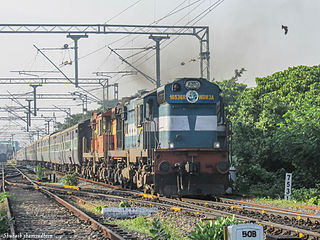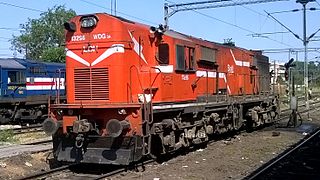
The American Locomotive Company was an American manufacturer that operated from 1901 to 1969, initially specializing in the production of locomotives but later diversifying and fabricating at various times diesel generators, automobiles, steel, tanks, munitions, oil-production equipment, as well as heat exchangers for nuclear power plants.
The Banaras Locomotive Works (BLW), formerly Diesel Locomotive Works (DLW), is a production unit of Indian Railways situated in Varanasi, Uttar Pradesh.

The Indian locomotive class WDM-2 is a class of diesel-electric locomotive that was developed in 1962 by American Locomotive Company (ALCO) for Indian Railways. The model name stands for broad gauge (W), Diesel (D), Mixed traffic (M) engine, 2nd generation (2). They entered service in 1962. A total of more than 2,700 WDM-2 was built at ALCO and Banaras Locomotive Works, Varanasi between 1962 and 1998, which made them the most numerous class of mainline diesel locomotive until its successor the WDM-3A.

The Indian locomotive class WDG-4 is a type of six-axle (Co-Co) freight-hauling diesel-electric locomotive with AC electric transmission designed by General Motors Electro-Motive Diesel in 1997–1998 for Indian Railways, where they are classed as WDG-4. Derived from the EMD SD70MAC, it is powered by a 4,000 hp (3,000 kW) 16-cylinder EMD 710G3B prime mover. Thirteen were built by EMD as order #958647, and a further eight were exported in kit form and assembled in India. The class entered service in 1999. A Dedicated Passenger version of this locomotive, the WDP-4, has also been produced, with a Bo1-1Bo Wheel Configuration, which entered service in 2001. These locomotives are also famous for, and can be identified, by the distinct and unique Jet Plane-like sounding capability of the EMD 710 prime mover.

The Indian locomotive class WDP-4 is a passenger-hauling diesel-electric locomotive with AC electric transmission designed by General Motors Electro-Motive Division and built by both GM-EMD and under license by Banaras Locomotive Works (BLW) of Varanasi, India for Indian Railways as the classes WDP4, WDP4B and WDP4D. The GT46PAC is a passenger version of the previous Indian Railways EMD GT46MAC freight locomotive. The locomotive has a 16-cylinder 710G3B diesel engine and is one of the fastest diesel-electric locomotives in service in Indian Railways.
The ALCO DL560C is a series of diesel-electric locomotive with AC electric transmission designed by the American Locomotive Company and produced under license by Banaras Locomotive Works (BLW) Varanasi, India for Indian Railways as their classes WDM-2, WDM-3A/2C, WDM-3D and WDG-3A for operation in India. The locomotive is fitted with a 16-cylinder ALCO 251 B, C diesel engine. In the early 1960s Indian Railways needed a reliable diesel workhorse to gradually replace its steam locomotive fleet. Equal numbers of ALCO's DL560C and EMD's G16 were chosen for trials. More locomotives of each of these were purchased for more trials. Indian Railways was keen on producing these locomotives in the country rather than depending on imports. EMD did not agree for a Transfer-of-Technology, while ALCO did. Thus ALCO DL560C was chosen for the job due to its easy maintenance, reliability and simple operation. And from then on vast numbers of this loco in different configurations have been produced and remain the main diesel traction power of Indian Railways.

The Indian locomotive class WDM-4 is a class of diesel-electric locomotive that was developed in 1962 by Electro-Motive Diesel for Indian Railways. The model name stands for broad gauge (W), Diesel (D), Mixed traffic (M) engine, 4th generation (4). They entered service in 1962. A total of 72 WDM-4 locomotives were built between 1961 and 1962.

The Indian locomotive class WDM-3A is a class of diesel–electric locomotive that was developed in 1993 by Banaras Locomotive Works (BLW), Varanasi for Indian Railways. The model name stands for broad gauge (W), Diesel (D), Mixed traffic (M) engine, with 3300 horsepower (3A). The WDM-3A is a later classification of earlier WDM-2C. They entered service in 1994. A total of 143+ were built at ALCO and Banaras Locomotive Works between 1994 and 2003 with rest of the 1246 units being rebuilt from WDM-2 which made them the most numerous class of mainline diesel locomotive until the WDG-4.

TheYDM-4 is a class of diesel locomotives operating on Indian Railways. The first units were built by the American Locomotive Company (Alco) in 1961. Since 1968, members of the class have been manufactured in India by the Banaras Locomotive Works (BLW), Varanasi. The model name stands for metre gauge (Y), diesel (D), mixed traffic (M) engine. The YDM-4 has been the most successful metre gauge diesel locomotive in India. The YDM-4 locos have a maximum speed of 100 km/h (62 mph), restricted to 85 km/h (53 mph).

The Indian locomotive class WDM-3D is a class of diesel-electric locomotive that was developed in 2003 by Banaras Locomotive Works (BLW), Varanasi for Indian Railways. The model name stands for broad gauge (W), Diesel (D), Mixed traffic (M) engine with 3300 horsepower (3D). The engine is classified WDM-3D though it outputs only 3300 hp and not 3400 hp as the name should suggest. They entered service in 2003. A total of 590+ WDM-3D were built at Banaras Locomotive Works (BLW), Varanasi between 2003 and 2016.

The Indian locomotive class WDP-3A, colloquially nicknamed the Toaster, is a class of diesel-electric locomotive that was developed in 1998 by Banaras Locomotive Works, Varanasi for Indian Railways. The model name stands for broad gauge (W), Diesel (D), Passenger traffic (P) locomotive with 3,100 horsepower (3A). The WDP-3A is a later classification of earlier WDP-2. They entered service in 1998. A total of 44 were built between 1998 and 2001.

The WDM-7 is a diesel-electric locomotive of Indian Railways. It has been manufactured by Banaras Locomotive Works (BLW), Varanasi. The model name stands for broad gauge (W), diesel (D), mixed traffic (M) engine. Today, these are found exclusively at Chennai Central and nearby area.

The Indian locomotive class WDG-3A is a class of diesel-electric locomotive that was developed in 1994 by Banaras Locomotive Works (BLW),Varanasi for Indian Railways. The model name stands for broad-gauge (W), Diesel (D), Goods traffic (G) engine, 3,100 hp (3A) locomotive. They entered service on 18 July 1995. A total of 1,164 WDG-3A units were built between 1994 and 2015 at BLW, Varanasi with a few units being produced by Diesel Loco Modernisation Works (DLMW) and Parel Workshop.

The Indian locomotive class WDS-6 is a diesel-electric locomotive used by the Indian Railways mainly for shunting and also for performing departmental duties. The model name stands for broad gauge (W), Diesel (D), Shunting (S) engine, 6th generation (6). As of April 2022, 375 units of this class are currently in use all over India.

The Indian locomotive class YDM-5 is a class of diesel-electric locomotive that was developed in 1964 by General Motors (GM-EMD) for Indian Railways. The model name stands for Metre gauge (Y), Diesel (D), Mixed traffic (M) engine, 5th generation (5). They entered service in 1964. A total of 25 YDM-5 locomotives was built between 1963 and 1964.

The Indian locomotive class WDG-5 is a class of heavy haul Diesel-electric locomotive built by Banaras Locomotive Works, Varanasi in collaboration with Electro-Motive Diesel. At a rated power output of 5,500 horsepower (4,100 kW), it is the second most powerful diesel locomotive class on Indian Railways, just out-powered by the 6,000 horsepower (4,500 kW) WDG-6G. Derived from the EMD SD80MAC, it was meant as a direct upgrade to the WDG-4 aka GT46MAC. The locomotive series is named Bheem, after the strong Pandav brother from epic Mahabharata. The loco has the 2-stroke Turbocharged EMD 20N-710G3B-ES of the EMD SD80MAC and an AC-AC transmission. Since the loco has been developed by installing a v20-710 prime mover and replacing the standard v16 in the WDG4 GT46MAC locomotive, the model was re-designated by adding 4 to the predecessor model, with GT-46 becoming GT-50, owing to the number of cylinders going from 16 to 20, thereby making it the First EMD locomotive in the GT-series to use a v20-710 engine.
The WDM-2G is a class of diesel electric genset locomotive used in Indian Railways. It is one of the rarest locomotives in India with only two units being produced by Patiala Locomotive Works (PLW). The locomotives were produced with an intention of being fuel efficient and to be used for light to medium duties such as short passenger runs along with occasional shunting. They are one of the only two classes of locomotives in India to feature multiple prime movers, the other example being WDS-6G, which was designed solely for shunting. They have a rated power of 2,400 HP.
The class WDS-3 was a diesel-hydraulic locomotive used by Indian Railways for shunting and doing departmental works. The model name stands for broad gauge (W), diesel (D), shunting (S) 3rd generation (3). The WDS-3 is used mostly in the Northern Railway Zone (NR). All these locomotives were withdrawn and scrapped by the late 1990s.
The Indian locomotive class WDM-6 is a class of Diesel locomotive that was developed in 1981 by Banaras Locomotive Works (BLW), Varanasi for Indian Railways. The model name stands for broad gauge (W), Diesel (D), Mixed traffic (M) engine, 6th generation (6). They entered service in 1981. A total of 2 WDM-6 was built at between 1981 and 1982. They were decommissioned at Burdwan (BWN) in 2011.


















